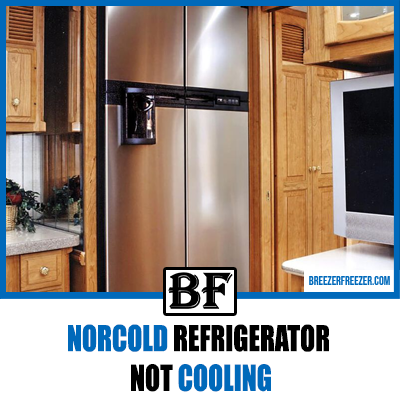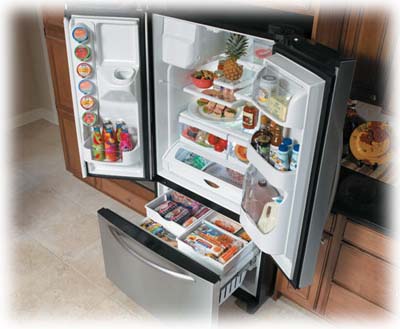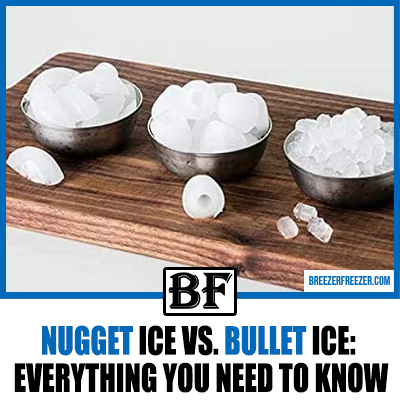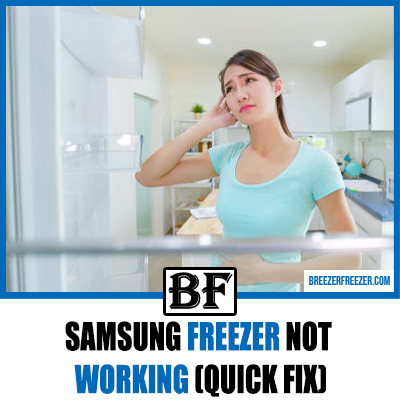Samsung Refrigerator Freezing Up
What can be more disturbing than opening your refrigerator only to find out that all your groceries have frozen up?

Of course, a refrigerator is one of the most important appliances that we have in our home. Not only does it keep fruits and vegetables fresh, but it also prevents them from spoiling.
However, much like other electrical appliances, it can also face issues because of daily wear and tear.
So, if you’re wondering, “why is my Samsung refrigerator freezing up?” then you’re at the right place. With our simple tips and tricks, you can fix this appliance whenever it gives you trouble.
Let’s dive in, then!
Reasons Why Your Samsung Refrigerator May Be Freezing Up
When your Samsung fridge keeps icing up every food item, soda, and milk bottle, you must consider calling a professional to fix the issue.
Though you can do that to diagnose the issue, we’d suggest taking a DIY route for detecting the problem.
On that note, here are some possible reasons why your fridge may be freezing up. Let’s take a look.
1. Temperature Control Thermostat
One of the reasons your refrigerator has started acting up lately may be a faulty thermostat. Essentially, this component controls the evaporator, condenser, and compressor of the fridge.
So, if yours is freezing, test the thermostat by turning it from high to low. You’ll probably hear a click, but if you don’t, then there might be something wrong with the thermostat. So, use a multimeter to check its continuity; if there’s no continuity, then know that the thermostat is faulty and needs to be replaced.
A malfunctioning thermostat doesn’t transfer electricity to the evaporator fan motor and compressor, due to which the system may operate longer than required.
Contrarily, we also suggest checking the air damper assembly, which opens and closes for the smooth operation of the fridge. If it is frequently open, then it might be the reason for your refrigerator freezing up
2. Thermistor
A faulty thermistor can also cause your refrigerator to malfunction, which is why you should consider testing it with a multimeter.
Besides the refrigerator’s temperature, you should notice a change in the thermistor’s resistance. But, in case there’s no continuity or the resistance doesn’t vary, the problem lies with the thermistor, which needs to be replaced.
Ways To Fix A Samsung Refrigerator Freezing Up But Not Cooling
Often you’ll see the refrigerator isn’t cooling, but there’s a frost buildup inside, and here’s how you can fix the ice buildup issue all by yourself:
1. Check The Ice Dispenser Flap
If you notice frost buildup in the refrigerator, the first thing to do is to check if the ice dispenser flap is closing properly. It needs to be closed securely, or else the humid air will flow into the fridge.
When the warm air of the outside is mixed with the cold air of the fridge, it will result in frost buildup. And so, remove debris or ice from its housing to ensure the dispense fits perfectly into it.
2. Ensure The Door Seal Latches Well
To ensure outdoor air doesn’t sneak into your fridge, make sure you check the door seals because it leads to frost buildup. As a result, it will affect the cooling capacity of the appliance, thereby leading to freezing issues.
DIY Tricks To Fix Your Freezing Samsung Refrigerator Ice Maker
1. There Might Be A Leak
Not to deny, ice maker freezing is one of the most common issues that homeowners face in Samsung refrigerators. So, if you also come across the same issue, there’s a high chance that there’s a leak.
To check for leaks, simply fill water in the dispenser bucket in the refrigerator door, and examine it from outside. Consequently, if water pours out, there’s a possibility of a leak.
Besides warm air, improper water drainage can cause freezing in the ice maker. And you can fix this by sealing the back and the left side of the ice maker compartment with silicone.
2. Faulty Circuit Board
If there’s no leak, but your ice maker is still freezing, there might be some issues with the circuit board, and you’ll have to get it replaced. Now, you cannot change the firmware and circuit board of the unit all by yourself, which is why getting in touch with Samsung Help Center will be the best bet.
Moreover, if the warranty of your fridge hasn’t expired, then the good news is that you might not have to pay for the repairs.
Quick Fixing Freezing Samsung Refrigerator Coils
Has your fridge started acting up lately because of the freezing of the evaporator coils? Consider defrosting them by turning off the refrigerator for at least 24 hours. However, there are some other ways that you can follow to fix this issue without having to call a professional.
1. Check The Defrost Heater
A defrost heater is in-built in the refrigerator to melt off frost from the evaporator coils. But, if there’s an ice buildup on the evaporator coils, then the defrost heater is either stuck at cooling mode or defective.
To figure out, you’ll have to test the heater using a multimeter and check its continuity. If you find none of them, then you’ll have to get it replaced through a professional.
2. Check If Door Seals Latch Properly
As you already know, outside air sneaking into the refrigerator causes frost buildup, which is why it’s important to check if door seals latch properly or not.
Also, if the seals are torn or broken, they won’t seal properly, resulting in leaks. If this happens, then make sure you reach out to Samsung Help Center for replacement.
Usually, the coils are cold, so when warm air enters the fridge, it freezes the coils through condensation. When that happens frequently, frost builds up more quickly than it should. Thus, the defrost process will be hampered, resulting in frequent frost buildups.
Things You Can Do When Samsung Refrigerator Drain Freezing Occurs
If your Samsung fridge drain is freezing up, then here’s what you can do to fix the issue.
1. Drain Heater
First off, you need to ensure whether your refrigerator comes with a drain heater that melts off frost to prevent clogging.
If your fridge has a drain heater, then use a multimeter to check whether it’s working or not. In case you find no continuity, you’ll have to get it repaired or replaced through a professional.
2. Drain Strap
Not every Samsung refrigerator features a drain strap, which is why you’ll first have to check if yours come with it or not.
Usually, a drain strap is a small piece of copper or aluminum that is connected to the defrost heater, which extends a bit down the drain. If you come across any such part in your fridge, then probably that’s a drain strap.
Firstly, check whether it is fitted into the drain heater perfectly or not; if it isn’t, then set it in the correct position. By doing so, it will transfer heat directly from the heater to the drain, which will melt off ice buildup.
Tips To Prevent Samsung Refrigerator Freezer From Freezing
Here are some tips that you can follow to prevent the freezer of your refrigerator from freezing.
1. Check if the freezer door closes properly, as humid air sneaking into the freezer can result in frost buildup through condensation.
2. Avoid stacking too many packages in the freezer and make sure nothing is leaning against the back wall as it can block the air vents.
3. Avoid opening the door too often and keep checking the seals to ensure perfect condition.
4. Make sure that the flap of the ice dispenser is aligned with its housing.
Frequently Asked Questions
How To Repair A Torn Freezer Door Seal?
Honestly speaking, a torn freezer door seal cannot be repaired, which means you’ll have to replace it with a new one to prevent air from entering the fridge. However, if your door seal has minor damage, you can get it repaired by a professional.
How Often Should The Water Filter Be Replaced?
Generally, replacing the water filter twice a year is recommended; however, we suggest you refer to the instruction manual of your refrigerator to be on the safe side. The average lifespan of the water filter also depends upon water quality.
How Cold Should My Refrigerator Be?
Ideally, you should set the temperature of your fridge between 35°F and 38°F. This temperature setting will keep your refrigerator cool enough so that the food remains fresh for a long time while avoiding freezing it.
Samsung Fixes:
- How To Reset Your Samsung Refrigerator
- How To Clean A Samsung Refrigerator Drawer
- How To Remove A Samsung Freezer Drawer
- Fix The Fan Noise On A Samsung Refrigerator
- How To Add Apps To A Samsung Refrigerator
- How To Reset The Filter Light On Your Samsung Refrigerator
- How To Fix A Samsung Refrigerator Ice Maker Jams
- Samsung Refrigerator Not Making Ice
- How Do I Reset My Samsung Ice Maker?
- Samsung Ice Maker Noise (How To Fix)
- Samsung Ice Maker Won’t Come Out
- How to Turn a Samsung Ice Maker On and Off
Summing It Up
With that, we’ve finally reached the end of our guide.
It’s indeed frustrating to find your refrigerator freezing up the milk, soda, soft drink, groceries, and all eatables stored inside it. However, you need not sweat out much as you can tackle freezing issues in a breeze without calling a professional.
Simply follow the tips mentioned above, and we are confident that you’ll be able to fix your refrigerator all by yourself without shelling out cash.
But before we bring the curtains down, here’s a last piece of advice – don’t hesitate to call a professional if you find fixing the issue all by yourself overwhelming. Also, make sure you go for a regular refrigerator maintenance contract to keep your fridge in top-notch condition.
Until next time!




